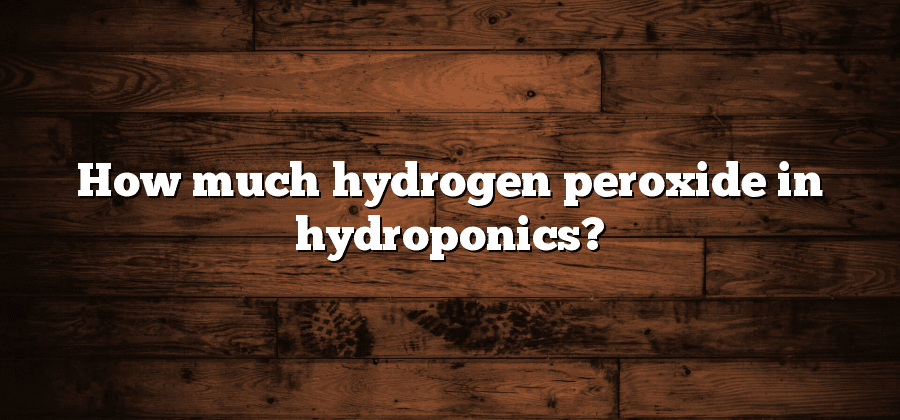Understanding the Role of Hydrogen Peroxide in Hydroponics
Hydrogen peroxide plays a crucial role in the world of hydroponics. As a powerful oxidizing agent, it serves a multitude of purposes in maintaining a healthy and efficient hydroponic system. In hydroponics, where plants are grown without soil and rely on nutrient-rich water solutions, hydrogen peroxide acts as a sanitizer, disinfectant, and oxygen booster.
One of the primary roles of hydrogen peroxide in hydroponics is to prevent and control the growth of harmful pathogens, such as bacteria, viruses, and fungi. These pathogens can thrive in the moist and nutrient-rich environment of hydroponic setups, posing a threat to the plants’ health. By adding hydrogen peroxide to the hydroponic solution, it effectively eliminates these pathogens, reducing the risk of disease outbreaks and improving overall plant growth. Additionally, hydrogen peroxide aids in increasing the oxygen levels in the water, promoting healthy root development and enhancing nutrient uptake by the plants. This oxygen boost is particularly beneficial in systems with low oxygen levels, ensuring plants receive an adequate supply for their metabolic processes.
The Benefits of Using Hydrogen Peroxide in Hydroponic Systems
Hydrogen peroxide has become increasingly popular in hydroponic systems due to its numerous benefits. One of the key advantages is its ability to promote oxygenation in the root zone. Hydroponic plants rely on dissolved oxygen in the nutrient solution for proper growth and development. However, inadequate levels of oxygen can lead to root rot and other detrimental conditions. By adding hydrogen peroxide to the nutrient solution, growers can help increase oxygen levels, ensuring a healthy root system for their plants.
Another benefit of using hydrogen peroxide in hydroponics is its ability to control and prevent the growth of harmful pathogens. Hydroponic systems provide a warm and moist environment, which is conducive to the growth of various pathogens like algae, bacteria, and fungi. These pathogens can wreak havoc on plant health and yield. Hydrogen peroxide acts as a powerful disinfectant, effectively killing these pathogens and preventing their spread. This helps to maintain a clean and disease-free environment, leading to healthier and more productive plants.
Factors to Consider When Determining Hydrogen Peroxide Concentration
When determining the hydrogen peroxide concentration to use in your hydroponic system, there are several important factors to consider. Firstly, it is crucial to consider the specific needs of your plants. Different plant species have varying tolerance levels to hydrogen peroxide, so understanding the requirements of your crops is essential for achieving optimal results.
Another factor to consider is the stage of growth your plants are in. Young seedlings, for example, may be more sensitive to higher concentrations of hydrogen peroxide compared to more mature plants. Additionally, the severity of any existing issues, such as root rot or fungal infections, should be taken into account when determining the appropriate concentration. Striking the right balance is crucial to ensure the hydrogen peroxide effectively addresses the problem without causing harm to your plants’ health.
Achieving the correct hydrogen peroxide concentration is not a one-size-fits-all approach. It requires careful consideration of your specific plants’ needs and the current state of your hydroponic system. By understanding these factors and making informed decisions, you can effectively harness the benefits of hydrogen peroxide while maintaining the optimal conditions for your plants to thrive.
The Potential Risks and Side Effects of Using Hydrogen Peroxide in Hydroponics
Hydrogen peroxide is widely used in hydroponic systems due to its ability to help control pathogens and promote root health. However, it is important to be aware of the potential risks and side effects associated with its use. One of the main concerns is the potential damage that hydrogen peroxide can cause to plant roots. While it can help combat root rot and other fungal infections, using hydrogen peroxide in high concentrations or for prolonged periods may lead to the destruction of beneficial microorganisms in the root zone. This can disrupt the balance of the hydroponic system and affect overall plant health and nutrient uptake. It is important to carefully monitor and regulate the concentration of hydrogen peroxide to prevent any adverse effects on the roots.
Another potential risk of using hydrogen peroxide in hydroponics is the potential for chemical burns. While hydrogen peroxide is generally safe to use when handled properly, accidental spills or splashes onto plant foliage or skin can cause irritation and burns. Therefore, it is essential to take appropriate safety precautions when working with hydrogen peroxide, such as wearing protective gloves and eyewear. Additionally, it is crucial to store hydrogen peroxide in a cool, dark place away from direct sunlight or heat sources to prevent degradation and the release of oxygen gas.
Guidelines for Safely Handling and Storing Hydrogen Peroxide in Hydroponic Setups
Hydrogen peroxide is a commonly used substance in hydroponic setups, but it is important to handle and store it safely to avoid potential risks and accidents. When working with hydrogen peroxide, it is crucial to wear protective gear such as gloves, goggles, and a lab coat to prevent any direct contact with the skin or eyes. Additionally, it is recommended to work in a well-ventilated area to minimize the inhalation of vapors.
To safely store hydrogen peroxide, it should be kept in its original container that is tightly sealed. It is important to ensure that the container is stored upright to prevent any leaks or spills. Furthermore, hydrogen peroxide should be stored in a cool and dry place, away from sunlight and sources of heat or ignition. It is advisable to keep it away from flammable materials and chemicals to prevent any potential reactions or fire hazards. Remember to always label the container with the date of purchase and the concentration of hydrogen peroxide to easily keep track of its shelf life and potency.
Handling and storing hydrogen peroxide in hydroponic setups requires careful attention and adherence to safety guidelines. By following these recommendations, hydroponic growers can ensure the safe use and storage of hydrogen peroxide, promoting a healthy and productive hydroponic system.






